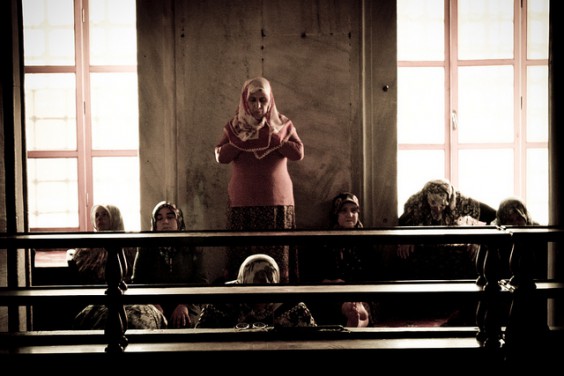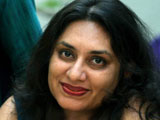Gender Apartheid: The Real No-Go Zones
by Bina Shah / February 16, 2015 / 2 Comments

Muslim women at prayer. Photo via Flickr user: PnP!
How male-only spaces in Muslim communities exclude women.
After the heinous Charlie Hebdo attacks, Fox News was quick to assert that there were areas of Paris in which only Muslims could enter. They claimed that non-Muslims and the police were prohibited from entering what they termed “No-Go Zones,” a blatant lie that the French media quickly and angrily picked apart. Unashamed, Fox News amplified the lie when so-called “expert” Steven Emerson stated on air that the entire town of Birmingham in the UK was a no-go zone. No less than David Cameron had to refute the false claim, calling Emerson “an idiot.”

- Pakistan is a country of contradictions – full of promise for growth, modernity and progress, yet shrouded by political, social and cultural issues that undermine its quest for identity and integrity. My bi-monthly column “Pakistan Unveiled” presents stories that showcase the Pakistani struggle for freedom of expression, an end to censorship, and a more open and balanced society.

- Bina Shah is a Karachi-based journalist and fiction writer and has taught writing at the university level. She is the author of four novels and two collections of short stories. She is a columnist for two major English-language newspapers in Pakistan, The Dawn and The Express Tribune, and she has contributed to international newspapers including The Independent, The Guardian, and The International Herald Tribune. She is an alumnus of the International Writers Workshop (IWP 2011).
Muslims rightly continue to be incensed as Louisiana governor Bobby Jindal repeated the lies about the no-go zones in his remarks to a British think tank. This kind of fear mongering, based on untruths, only works to divide communities. However, while much has been made about the fact that no-go zones don’t exist, everyone is ignoring a bigger truth: that no-go zones based on religion do exist, but not in the way one might think.
Instead of zones based on Muslims and non-Muslims, Muslim communities have no-go zones for women. These no-go zones have existed for much longer and been much more accepted than the fictitious no-go zones of Paris or Birmingham, because they involve an oppressed group that many Muslim communities drive to silence and invisibility.
To take the most obvious example, consider Muslim women and the mosque. Many mosques do not maintain a space for women to pray in the main congregation, banishing them instead to cramped quarters in a separate hall or upstairs balcony. In Islam, the only mandate concerning women praying with men is that they should stand behind the men, so men do not observe women performing sajdah, or prostration. This mandate is meant to preserve the physical integrity and respect of women.
But overzealous Muslims have taken this as a green light to physically separate the women from the men, even going as far as to make separate entrances for men and women in the mosque. And in many mosques in my home country of Pakistan, the belief is that women should not even come to the mosque but say their prayers at home. In the Sunni-dominant tradition of Pakistan, there’s precious little space for women, although the Shia places of worship are more inclusive.
Amina Wadud, a renowned American Muslim scholar, has led mixed-gender prayers in the attempt to reclaim sacred space for women. Asra Nomani, author of Standing Alone, has taken this issue up as well. In the wake of their activism, a group of Muslim women have created the Women’s Mosque in Los Angeles. Mosque co-presidents Sana Muttalib and M. Hasna Masnavi envision it as a place where women can feel safe and included, where their bodies will not be policed, and their space will not be limited to balconies and side-rooms. But this movement is seen as controversial, and remains accessible to only a small percentage of progressive and liberal Muslims in the United States.
In recent years, we’ve seen the popularization of the term gender apartheid to describe the kind of gender segregation we see in orthodox versions of religion (Orthodox Judaism and conservative Christianity included). Yet this kind of harsh separation of men from women doesn’t just take place in the mosque. Blocking of access, opportunity, and visibility in Muslim communities has become practically institutionalized in all levels of society, spreading out from the personal, private areas in which they originated.
Nowhere is this more poignantly illustrated than in Rafia Zakaria’s recent book The Upstairs Wife: An Intimate History of Pakistan. Zakaria’s novel is a retelling of the history of Pakistan through the eyes of its women, a perspective that is all too often overlooked in male-written history books. Zakaria shows the “socially constructed history of women” through writing about her own family’s experience of migrating from India to Pakistan at the time of Partition. Zakaria argues that General Zia’s Islamization campaigns of the 1980s greatly diminished women’s roles in Pakistan.
Into the historical thread, Zakaria weaves a very personal story of her uncle’s decision to enter into a second marriage while he was still married to his first wife, Zakaria’s aunt Amina. The events that follow this marriage, undertaken without the permission of his first wife, split the family house into two sections, one for the first wife and one for the second, with Zakaria’s uncle shuttling between the two stories. For the entire duration of the second marriage, the first wife never entered the second wife’s living space, and vice versa.
The uncle’s second marriage – and the creation of virtual no-go zones for women even within their own homes – would never have been possible without the regressive laws put in place by General Zia and his mullahs. They changed the Muslim family laws promulgated by his predecessor, the dictator General Ayub. Zia removed the legal curbs Ayub had placed on polygamy, making it far easier for Muslim men to marry more than once for any reason, to remarry without obtaining the permission of their first wife, and to divorce a woman instantly.
This column is far too limited to discuss the religious-based support for these unfair, man-made laws envisioned by misogynists (in a nutshell, it doesn’t exist). But seen in this light, the connection between the personal choices of Muslim men and the vanishing of space and agency for Muslim women becomes all too clear. If it weren’t for the personal bravery of women like Amina Wadud, Asra Nomani, Rafia Zakaria, and the countless other Muslim women fighting hard to reclaim their rightful space in public and private, as well as personal and political arenas, the no-go zones for Muslim women would continue to expand.





2 Comments on "Gender Apartheid: The Real No-Go Zones"
No one could have witten a better article on this topic than you . Your insight and understanding of this unjust and insensitive prejudice based on religion has brought forth a window for awareness but the main perpetrators will not listen ,at leasr notfor some time. Misogyny, hatred towards women has closed the eyes and ears of Muslim men . They do not understand that only a just egalitarian society will progress in the modern world .Alas the men who understand this are so few.
It has nothing to do with religion or “zealot” (a word specifically used for Christian Zealots). Rather, it is immersed in culture of the people of some lands. Yes, you are right that in Islam there is no restriction on women to participate in congregational prayer – however, the areas where women are disallowed to perform prayer, (they) are driven ignorantly by the culture (which they have sadly mixed with Islam).